Wisconsin Uses Millions of Tons of Salt
Polluting our land and water and increasing Lake Michigan's salinity. First story in a series.
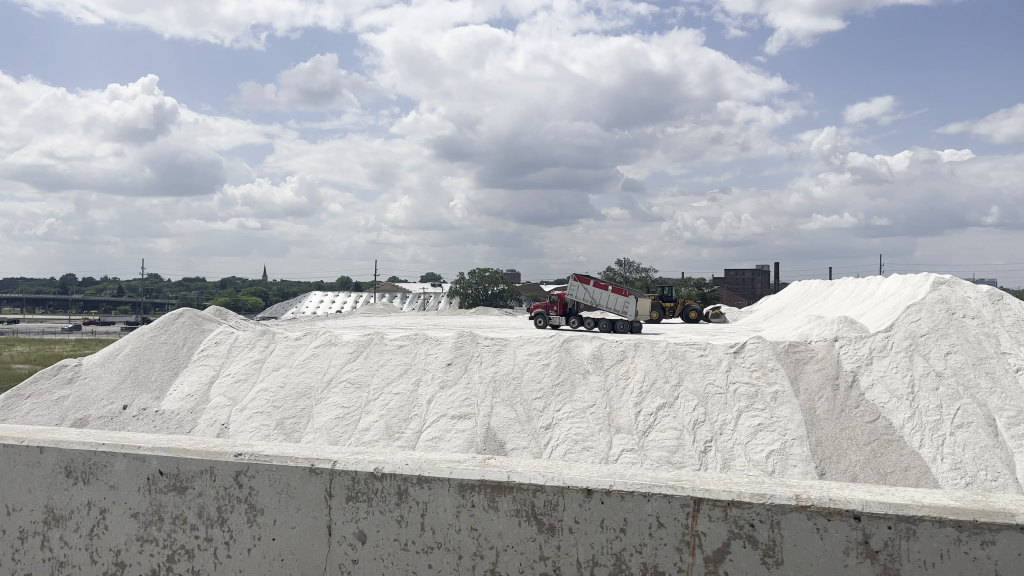
Port Milwaukee leases space used by three vendors who stockpile mountains of road salt like this one seen in August 2023. Photo by Kareem Benson-White.
Salt.
Sodium chloride.
The same mineral we eat, pour from shakers, and ingest in processed foods— is used across the state to de-ice roads and walks, in order to keep society safely moving.
But salt comes with hidden costs.
The immense quantities applied over the years wash off impervious surfaces into our soil and water.
So much so that the salinity of Lake Michigan is actually increasing.
Every winter we dose our land with over a million tons of a pollutant that is building up in our water with harmful effects for life.
Where Does Milwaukee’s Salt Come From?
The story of salt begins with tropical seas some 400 million years ago—when the tectonic plates of planetary crust that became our Great Lakes region floated atop the superhot mantle near Earth’s equator.
Depicted at the Milwaukee Public Museum’s popular Silurian Reef exhibit, featuring squid-like cephalopods hovering underwater above hand-sized trilobites, after 20 million years of climatic warming, these reef-sequestered shallows evaporated and left behind a layer of salt.

The Silurian Reef exhibit at the Milwaukee Public Museum depicts shallow seas that later evaporated to leave behind a layer of salt deposits beneath the central Great Lakes region. Photo by Michael Timm.
Geologically part of the Salina Formation, these salt deposits are buried hundreds of feet beneath Michigan, Ohio, Pennsylvania, New York, and the Canadian province of Ontario.
Deep below the rims of Lakes Erie and Huron, miners excavate salt in marvelous manmade caverns evoking the lair of a Bond villain.
Among other purposes, salt is mined as “rock salt” like that piled into black-shrouded mounds on Milwaukee’s Jones Island where the “dry bulk” commodity is offloaded from self-unloading freighters, before being distributed by thousands of truckloads to communities across Wisconsin for de-icing winter roads.
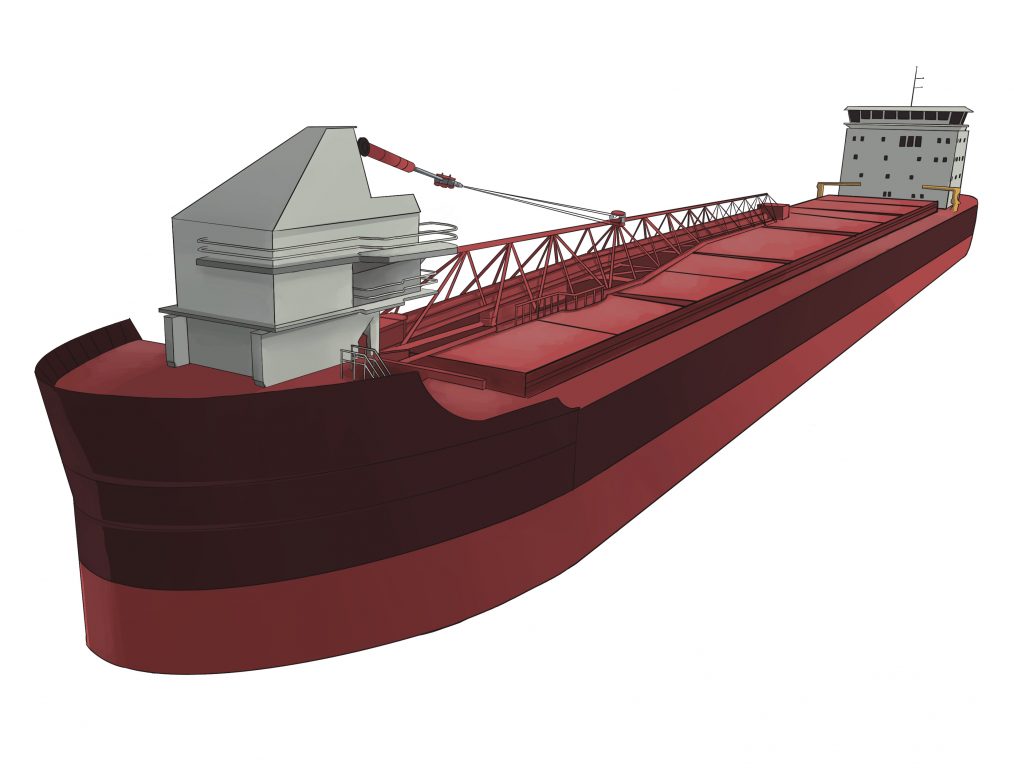
A self-unloading dry bulk carrier like those in the Canadian Algoma Central Corporation fleet contains a boom that unladens tens of thousands of tons of salt from the vessel’s hold. Ships like this one routinely voyage from Canadian ports on the Great Lakes, including Goderich, Ontario, carrying salt to Milwaukee. Illustration by Sydney Hoffman.
Through various subsidiaries, three major salt vendors operate through the Port of Milwaukee: Cargill, Compass Minerals, and Morton. Milwaukee imports more salt than Green Bay or Chicago and is a major distribution node of road salt to communities in 16 Wisconsin counties as far west as Sauk County and as far north as Fond du Lac.
The slogan of one company—“Morton Salt is an American way of life”— is apt, for salt has become a key ingredient dissolving invisibly into the recipe of modern society. If we want to move freely about our business during icy winters, applying salt to human surfaces has become the default conditioned response.
Just how much salt moves through Port Milwaukee, “an economic entity of the City of Milwaukee government” governed by a publicly appointed Board of Harbor Commissioners?
Madison Goldbeck, Port Milwaukee’s marketing and communications officer, declined to provide exact figures, referring inquiries to Port tenants.
“Dry bulk commodities, which include salt, are the largest type of commodity handled at Port Milwaukee. During 2023 over 50% of dry bulk commodities handled at Port Milwaukee consisted of salt,” Goldbeck said in an email. “I suggest reaching out to the tenants you mentioned, as we do not share tenant-specific information because they are private companies.”
Through a company spokesperson, Kinder Morgan, which handles salt imported from Morton’s Canadian counterpart K S Windsor Salt Ltd., declined to comment. Through a company spokesperson, Compass Minerals, which imports salt from what Compass’s website describes as the world’s largest underground salt mine beneath Goderich, Ontario on the eastern shore of Lake Huron, declined to comment. Cargill, which according to public accounts has operated a salt mine beneath Cleveland, Ohio that extends beneath Lake Erie, did not respond to a request for information.
But federal data sheds light on the question. The U.S. Census Bureau tracks commodity imports when ships unload their cargoes at ports. A review of the past two decades of salt imports through Milwaukee provides a baseline for comparison. In 2023, Milwaukee imported 660,065 metric tons of salt (1 metric ton = 1,000 kilograms). These figures likely undercount actual tonnage, as Army Corps of Engineers Waterborne Commerce data, available for 2009 through 2021 and including both domestic and foreign shipments, routinely tally slightly larger figures.
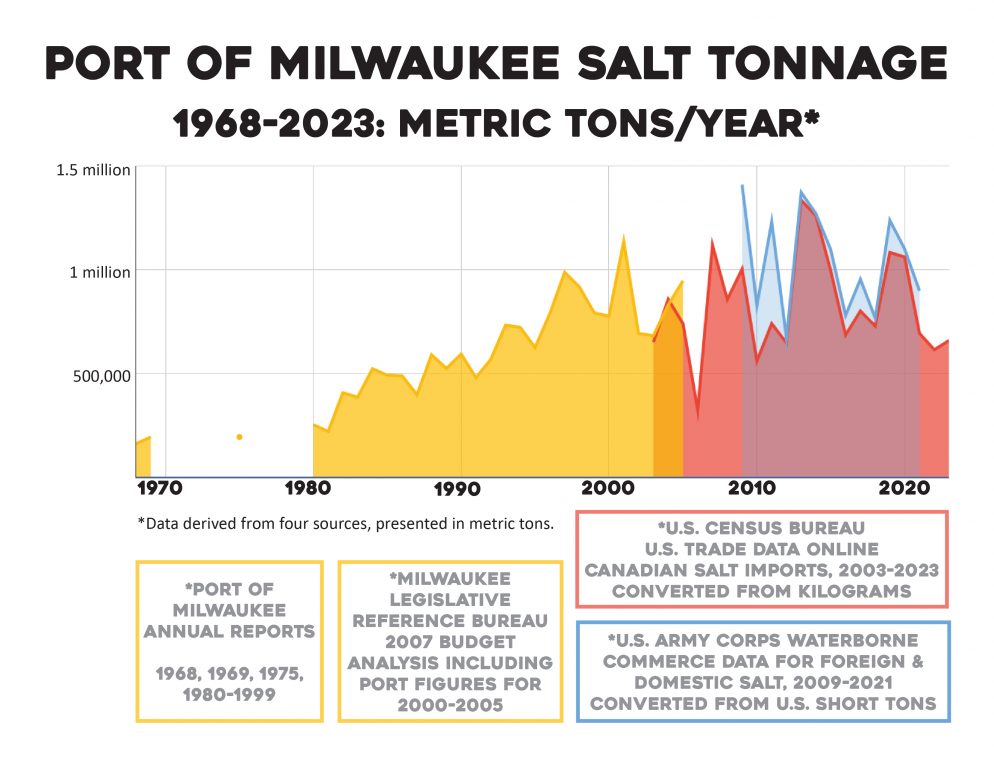
*Data derived from four sources, presented in metric tons. Special thanks: Milwaukee Public Library Humanities Department; City of Milwaukee Municipal Research Librarian Kathy Williams; USGS Research Hydrologist Steven Corsi; Tim Grundl, Professor Emeritus, Geosciences Department and School of Freshwater Sciences; USGS Commodities Specialist Wally Bolen.
Salt supply and demand fluctuate year to year in response to winter severity, prior-year stockpiling, and other factors like labor disputes. The U.S. Census Bureau tracked 17.4 million metric tons of salt moving through Port Milwaukee over the past 21 years for which data were available, 2003 through 2023. The average size of the annual import was 829,598 metric tons. The high was 1.33 million metric tons in 2013 and the low 322,248 metric tons in 2006.
Other sources trace the journey of salt across our freshwater Great Lakes.
Vessels like the Algoma Innovator, a 650-foot-long self-discharging bulk carrier built in 2017, routinely transport salt from Goderich, Ontario, location of Compass Minerals’ salt mine, to Milwaukee. From 2019 through 2023 the Algoma Innovator made 41 Milwaukee port calls—the most of any vessel—unlading 879,000 metric tons of salt. Over that time, it transported 2.8 million metric tons of salt from Goderich, meaning that Milwaukee comprised about a third of its salt duty. That’s according to publicly available data reviewed from ImportInfo, which maintains a database derived from bills of lading, legal shipping documents which are provided to U.S. Customs officials on port calls but then filed away out of public view. These bills comprise the source for the public U.S. Census Bureau and U.S. Army Corps of Engineers Waterborne Commerce data, which aggregate individual shipment records into monthly and annual tallies.
A recent shipment logged for February 2024 included just shy of 27,000 metric tons of rock salt.
According to a 2014 Toronto Star report, one shipment of this scale is close to the daily output capacity of the Goderich mine—23,000 metric tons. The Star reported the mine produces 6.3 million metric tons of salt per year and was expected to remain viable for 120 years.
Other vessels in the Canadian-based Algoma Central Corporation fleet—Algoma Buffalo, Algoma Compass, Algoma Conveyor, Algoma Intrepid, Algoma Niagara, Algoma Sault, and Algoma Transport—have also made calls on Milwaukee from Goderich, all transporting salt.
Salt is a major part of Port Milwaukee business—comprising roughly one-third of annual tonnage. Salt operations use over 25 acres of land.
Compass Minerals leases just over 10 acres of Port property on eight parcels, near E. Lincoln Avenue and S. Bay Street in Bay View. The salt piles closest to the Lincoln Avenue Viaduct are here.
Kinder Morgan leases a number of Port parcels, including 7.68 acres designated for salt, closer to I-794. An energy infrastructure company, Kinder Morgan provides bulk materials handling. Based on a review of vessel calls, the salt piled here appears to originate from the Morton-affiliated salt mine in Windsor, Ontario, just across the Canadian border near Detroit.
Over the past four decades, salt imports have clearly increased at Milwaukee. Salt has always been a major component of the Port’s bulk tonnage, but has also grown as an increasingly dominant factor in annual tonnage overall. That’s according to a review of Port of Milwaukee annual reports from 1980 through 1999, when the Port routinely published per-commodity annual tonnage. In 1980, the earliest year for which consistent figures were reported, the Port reported handling 254,725 metric tons of salt. Over the ensuing decades this figure climbed as high as 987,833 metric tons for 1997.
This increase is coupled with a regional increase in population, development, and impervious surfaces over same period.
Salt is a multi-national, multi-billion-dollar business characterized by increasing mergers and acquisitions. Highway deicing accounted for about 41% of total salt consumed nationally in 2023, according to a U.S. Geological Survey mineral commodities report.
The Customs value of those 660,000 metric tons of salt delivered to Milwaukee in 2023 was about $21.1 million, according to the U.S. Census Bureau figures.

The cost of salt is rising. Sold by the (U.S.) ton (including trucking costs to local salt depots averaged across Wisconsin) to public entities through the shared Wisconsin Department of Transportation salt bid, this chart shows the average per-ton cost for road salt to Wisconsin communities based on 20 years of WisDOT data.
It is sold to local communities for over twice as much.
Compass Minerals International, Inc., headquartered in Kansas City, Mo., is publicly traded on the New York Stock Exchange. Compass was formerly North American Salt Company, itself formed from the merger of various salt firms in 1990.
Morton Salt and its Canadian counterpart were sold for $3.2 billion in 2020 to Stone Canyon Industries, a holding company whose portfolio includes Kissner, Morton Salt, Detroit Salt. Co., NSC Minerals, Central Salt, Lyons Salt Company, Lobos, and Windsor. It is the world’s largest salt producer, according to its website, claiming capacity to produce 29 million tons of salt per year.
Cargill is a privately held company that markets a variety of salt products for food and other uses.
Every year local Wisconsin communities spend millions of dollars purchasing salt to spread onto winter roads. (While the commodity is shipped in metric tons, the following costs are per U.S. tons. 1 ton = about 0.91 metric tons.)
The City of Milwaukee reported using 26,619 tons of salt in 2023 at a cost of $81.29 per ton, which includes delivery charges. That’s over $2.1 million.
Per-ton costs appear to be rising far beyond inflation—even as municipalities like Milwaukee are starting to apply salt more efficiently. In 2019, just five years ago, the City of Milwaukee reported using 44,832 tons of salt at a cost of $47.78 per ton.
The City of Milwaukee has a standard three-year contract with Cargill for salt, according to Tiffany Shepherd, marketing & communications officer for Department of Public Works.
Other local communities and jurisdictions obtain salt through the Wisconsin Department of Transportation’s shared salt bid, according to Cody Churchill, WisDOT winter maintenance engineer.
For the 2022-2023 season, 25 public entities in the county—including the State of Wisconsin, Milwaukee County, MMSD, and all municipalities (except the City of Milwaukee and West Milwaukee)—participated in the shared bid sourced from Compass Minerals salt imported to Port Milwaukee. For 2022-2023 the per-ton cost for Milwaukee County entities was $69.90, or just over $4.5 million.
In all, the State of Wisconsin DOT salt bid procured 681,059 tons of salt from Compass for over $55 million for the 2022-2023 season and 230,426 tons from Morton for $18.7 million. That supplied about 460 Wisconsin public entities statewide and includes salt shipped through the Great Lakes via Milwaukee, Green Bay, Marinette, and Duluth/Superior and also along the Mississippi River at Dubuque, La Crosse, Winona, St. Paul, and Prairie du Chien.
But that’s just the beginning of what salt costs us, as our next stories will show.
This is the first story in a series by Michael Timm, a Milwaukee Water Storyteller for the nonprofit Reflo, who did our earlier series on reintroducing the sturgeon into the Milwaukee River. He holds a 2013 master’s degree in freshwater science from UW-Milwaukee. He previously wrote and edited for the Bay View Compass newspaper.
This project is funded by the Wisconsin Department of Administration, Wisconsin Coastal Management Program and the National Oceanic and Atmospheric Administration under the terms and conditions of Wisconsin Coastal Management Program Grant Agreement No. AD239125-024.21. Funded by the Wisconsin Coastal Management Program and the National Oceanic and Atmospheric Administration, Office for Coastal Management under the Coastal Zone Management Act, Grant # NA22NOS4190085


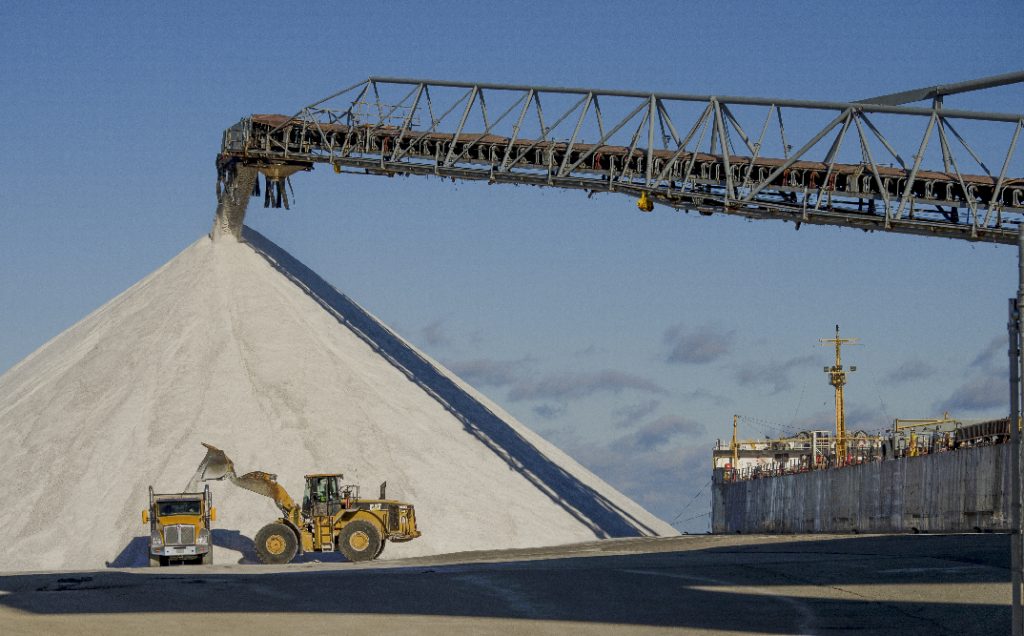
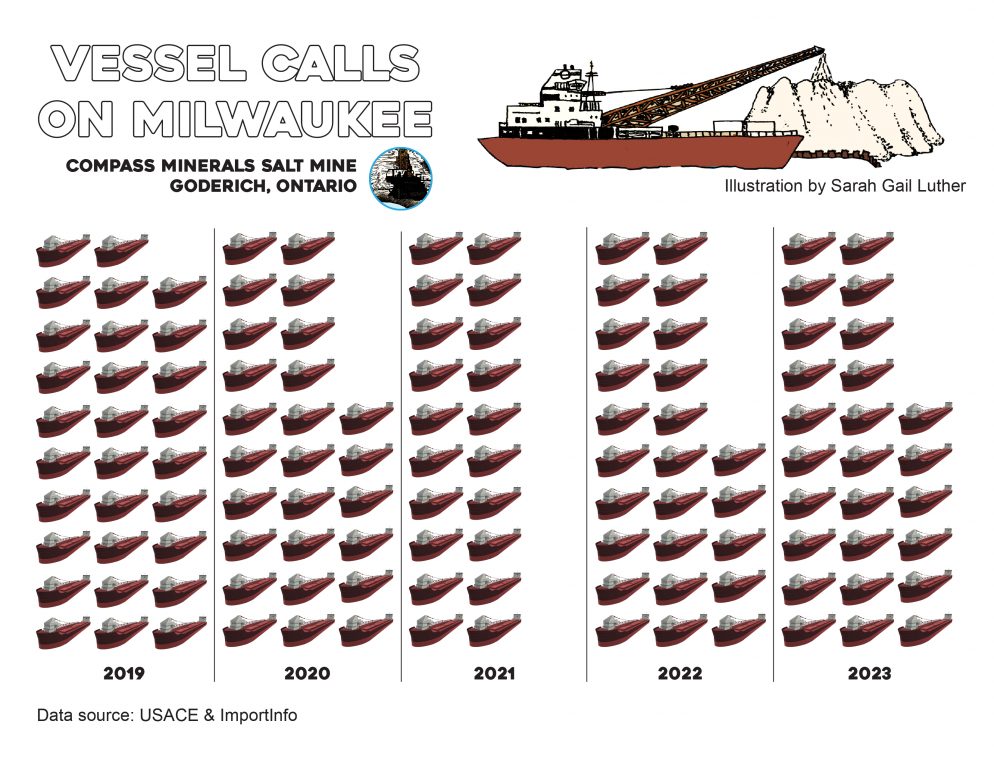
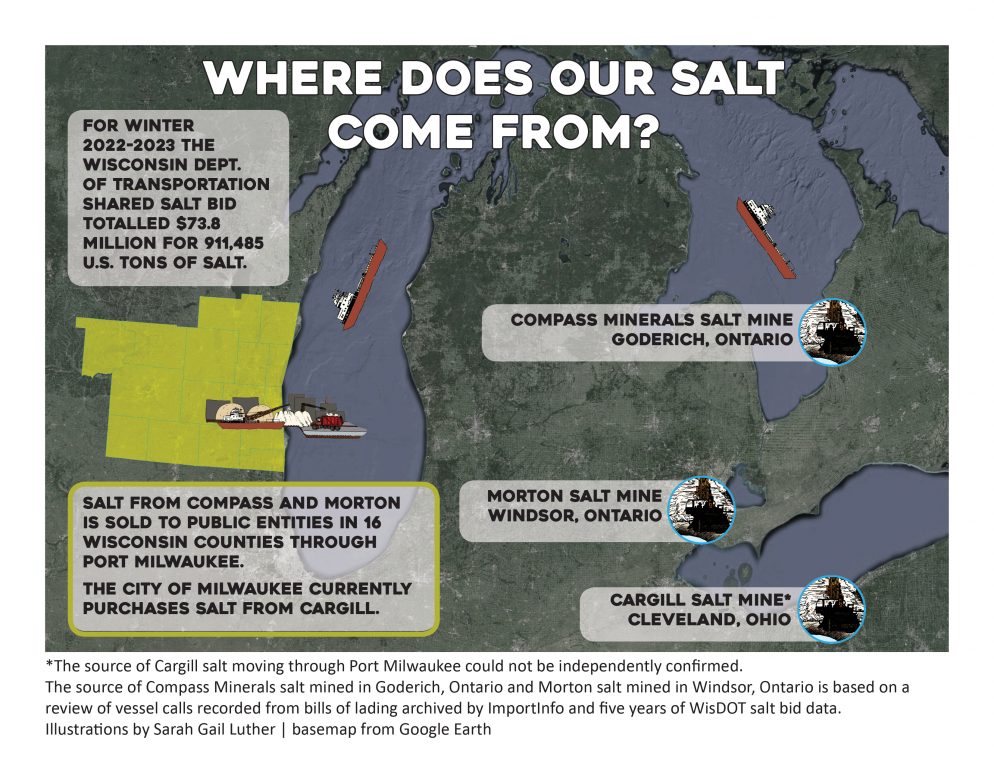

















And, note that the I-94 expansion will add another 54 acres to our highway system — so more spreading of more salt.
SALT One of the few stories I remember from 4th or 5th grade history was that the Romans PLOWED SALT into the soil of Carthage. Who knows why that simple fact has remained in my mind for 68+ years. But look at the piles of salt on Jones Island and think that each year half or more than half goes into Lake Michigan. That does not include the salt that goes into the Lake from the Michigan side The SALT NEVER LEAVES it is heavier that fresh water.